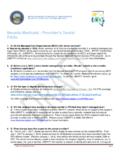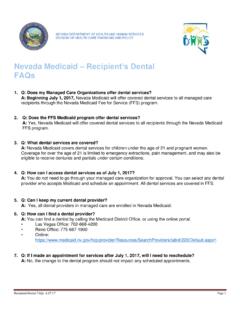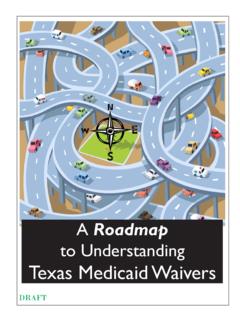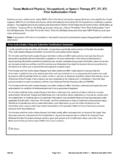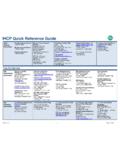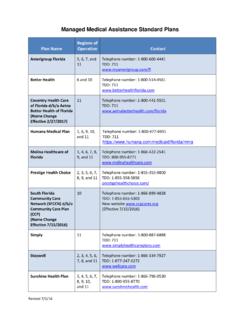Transcription of New York Medicaid Eligibility and Limits for …
1 Scolaro, Fetter, Grizanti, McGough & King, New york Medicaid Eligibility and Limits for Income, Assets and Spousal Impoverishment, 2016 Changes What is Medicaid ? Medicaid is a needs based system, whereby only persons who are in financial need will qualify for Medicaid . Medicaid is not to be confused with Medicare, which is not a needs based system. What does Medicare pay for? Medicare is government subsidized health insurance which is generally only available for persons 65 and older. There are now four (4) parts to Medicare: Part A (hospital insurance with limited nursing home coverage), Part B (medical insurance - physician and outpatient coverage), Part C (private all-inclusive plan) and Part D (prescription drugs). In order for Medicare Part A. to cover the costs of a nursing home, the patient must have been in the hospital for three consecutive days (including the day of admission) and must enter the nursing home within 30.
2 Days of leaving the hospital. Medicare generally Limits patients to 100 days of coverage per illness. The first 20 days of nursing home care are covered in full. For days 21 through 100, there is daily coinsurance (currently $157 per day) required to be paid by the patient. In addition, Medicare will typically only cover patients for therapy and physical rehabilitation, and will not cover extended custodial care (like bathing and dressing). As of January 1, 1999, the Medicare Advantage (formerly known as Medicare+Choice and also referred to as Part C) program permits an array of private Medicare options, including Health Maintenance Organizations (HMOs) [available since 1982], Provider-Sponsored Organizations (PSOs), Medical Savings Accounts (MSAs), Preferred Provider Organizations (PPOs) and Private Fee-For-Service Plans (PFFS).
3 These health plans must cover items and services offered by traditional Medicare under Parts A and B. 42 Section 1395w-21, et. seg.; 42 Section 422. Beginning January, 2003, PPO demonstration plans became available in 23 states, including New york . Beginning January 1, 2006, Medicare began offering the new prescription drug coverage program called "Medicare Prescription Drug Coverage" (also referred to as Part D). Medicare Prescription Drug Coverage will help individuals with their prescription drug costs, no matter how they currently pay for them. Everyone with Medicare has the option to join a drug plan to obtain this coverage, but everyone is required to make a decision about their drug coverage. Individuals could join as early as November 15, 2005. If an individual does not elect to join when first eligible, they may pay a penalty if they later elect to join.
4 507 Plum Street, Suite 300, Syracuse, NY 13204 Page 1. Scolaro, Fetter, Grizanti, McGough & King, Individuals with little or no income and resources may be eligible to receive the Medicare Prescription Drug Coverage program with little or no cost. There are different plans that can be chosen and each plan's cost varies depending on what it covers. For example, the individual can choose a plan that covers only prescription drugs and then keep the rest of their Medicare coverage the same or can join a Medicare Advantage or other Medicare Health Plan to cover physician and hospital care in addition to prescription coverage. Individuals who receive prescription drug coverage through their employer or union should contact their benefits administrator to discuss their options.
5 If Medicaid is needs based, who qualifies for Medicaid ? There are several different standards for which Medicaid will judge a person's availability: Individuals: For an individual seeking home care aid - a person cannot have more than $14,850 in resources and $825 a month in income (plus an unearned income credit of $20 per month). For an individual seeking nursing home aid - a person cannot have more than $14,850 in resources and $50 of income. If the individual seeking home care or nursing home aid has income above the required level, he or she must have medical expenses that exceed the income overage. For example, if an individual applying for home care aid has $1,245 of monthly income, he or she must have monthly medical expenses over $400 (or $1,245-$845) to meet the income test.
6 Married Couples: For a married couple seeking home care aid, they cannot have more than $21,750 in resources and $1,209 a month in income (plus an unearned income credit of $20 per month). With married couples in which one spouse is seeking nursing home aid, it is important to distinguish between the Institutionalized Spouse (the spouse in the nursing home) and the Community Spouse (non-institutionalized spouse). Medicaid will deem that it is the responsibility of the Community Spouse to support the institutionalized spouse. Therefore, Medicaid will consider all of the Community Spouse's non-exempt assets available for care except the Community Spouse may retain up to $119,220 but a minimum of $74,820 in non- exempt assets/resources and $2, per month ($35,766 per year) of income.
7 If a couple's total non-exempt asset level is between $149,640 and $238,440, the Community Spouse is entitled to retain one-half (1/2) of the combined non-exempt asset level. If the combined non- exempt asset level exceeds $238,440, the Community Spouse is entitled to retain only the $119,220 amount. For simplicity purposes, the $74,820 resource level will be referred to for the remainder of this outline. The amount of assets/resources that the Community Spouse is allowed to keep is known as the Community Spouse Resource Allowance or CSRA . The amount of 507 Plum Street, Suite 300, Syracuse, NY 13204 Page 2. Scolaro, Fetter, Grizanti, McGough & King, monthly income that the Community Spouse is allowed to keep is known as the Minimum Monthly Maintenance Needs Allowance or MMMNA.
8 Prior to September 24, 2013, the protections of the CSRA and the MMMNA were only available to married couples where one spouse is in a nursing home or in the Long Term Home Health Care program (or Lombardi program). Beginning on September 24, 2013, these protections are available to married participants in all Managed Long Term Care (MLTC). programs, including the Program for All-Inclusive Care for the Elderly ( PACE ) and Medicaid Advantage Plus plans. What if the Community Spouse's resources are more than $74,820? Those assets will need to be liquidated to pay for the cost of a nursing home before the Institutionalized spouse will be eligible for Medicaid . What if the Community Spouse's income is in excess of $2, per month? The income which is in excess of $2, per month will need to be contributed to defer the cost of the nursing home; however, only 25% of such excess income will be available, not 100%.
9 If the Community Spouse files a Spousal Refusal Statement (see below), none of such excess income will be available. Are there any exceptions to the available resource rule? Yes, in addition to the $74,820 of resources a Community Spouse may have, the Community Spouse may also retain: 1. The Primary Residence up to a maximum home equity limit of currently $828,000, so long as the Community Spouse still resides in the home or the individual has the subjective intention to return to the Primary Residence after the individual's stay in the nursing home; New york elected to increase the amount of equity an individual is permitted to have from $500,000 (which was the minimum amount required under the Deficit Reduction Act of 2005) to $828,000. 2. One automobile;. 3. Essential personal property ( clothes, furniture, phone, television, etc.)
10 ;. 4. $1,500 of cash value of life insurance;. 5. $1,500 burial account;. 507 Plum Street, Suite 300, Syracuse, NY 13204 Page 3. Scolaro, Fetter, Grizanti, McGough & King, 6. Unlimited pre-paid irrevocable funeral contract, provided any funds not used for funeral expenses must be paid to Medicaid to the extent of Medicaid benefits paid; and 7. Other various smaller items ( , burial plot, etc.). Transfer of Assets: In order to prevent individuals from inappropriately establishing financial Eligibility for Medicaid by giving assets to family members, the transfer of assets rule was established. The following paragraphs describe Medicaid after to the passing of the Deficit Reduction Act of 2005 ("DRA 2005") by the Federal government on February 8, 2006. Please feel free to contact me if you would like to discuss how transfers made prior to February 8, 2006 are going to be treated by Medicaid .

